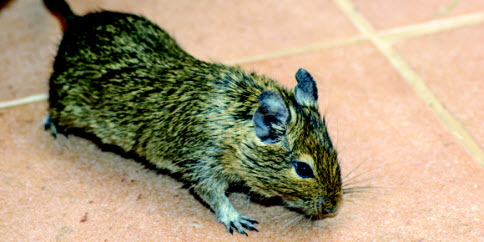If you see a mouse in your house, you can be sure there is more than one unless it’s moving day. Mice leave pheromone trails in their urine for their friends and fellows to follow and to provide themselves with navigational tools. Mice multiply rapidly, producing five to 10 litters a year, with each of their three to 16 offspring becoming capable six weeks later of producing their own families. An individual mouse can live four years.
The common house mouse, Mus musculus, was imported here from southern Asia and it loves to raise its family in your snug, warm home. Mus musculus have large ears and small eyes and feet, are brown to dark grey with lighter bellies and weigh less than 28 grams.
Native deer mice, Peromyscus maniculatus, will also invade buildings. These mice look quite similar, but their scaly tails are brown on the top and white underneath. Disney made the mouse look cute and lovable, but deer mice can carry the deadly hantavirus in their feces which, when breathed in by humans, can lead to respiratory failure with a 38 per cent fatality rate. There is no “cure,” only treatment. Avoid contact with droppings and wear a mask when cleaning mouse-infected areas.
Mice can squeeze through incredibly small openings — as tiny as one-quarter inch in diameter. When closing up possible entry points to your home, be sure to plug the hole with something they can’t chew through. Exterminators suggest high-quality copper wool, backed up by caulking.
Mice are also incredibly athletic. They can jump, straight up, 30 centimetres (one foot) off the ground and another 2.5 metres (over six feet) down without injury. They can also swim. They can climb sheer rock or brick.
Mice sleep 12 hours a day, generally during daylight, so catching sight of them can be tricky. They are famous for their dim eyesight, although they can see better than you might think and they use their whiskers as a navigational aid. They have extremely keen hearing.
A study at the University of California has discovered that when mice are infected with a parasite that can only complete its life cycle in the gut of a cat, the mouse brain is affected in a way that makes it lose its fear of cats. This way, from the parasite’s point of view, it can get back into the cat’s digestive system and reproduce. The mouse only has to come into contact with the feces of a cat to be infected.
The parasite, Taxoplasma gondii, not only has a long-term effect on the brains of mice, it has been linked to mental illness in humans. It is estimated that 60-million Americans are infected with Taxoplasma gondii, which is linked to schizophrenia, bi-polar disease, OCD and even clumsiness!
Mice are overwhelmed by highly-aromatic substances such as cloves, peppermint oil and mothballs. Apparently, they do not like walking on tinfoil so you can try covering countertops to keep them from those surfaces.
They are not that stupid, though. They can sense danger and will avoid mousetraps that have been sprung. In one case, the mice carefully separated poison tablets from bait and neatly left the tablets in a muffin tin for the homeowner to discover.
If you are an animal lover and trap live mice to remove to another jurisdiction, you better make sure the location is far away. Even though, in general, mice don’t stray far from home (12 to 25 feet in search of food), mice have been tracked returning to their homes from as far away as 1.2 miles (1,980 metres).



